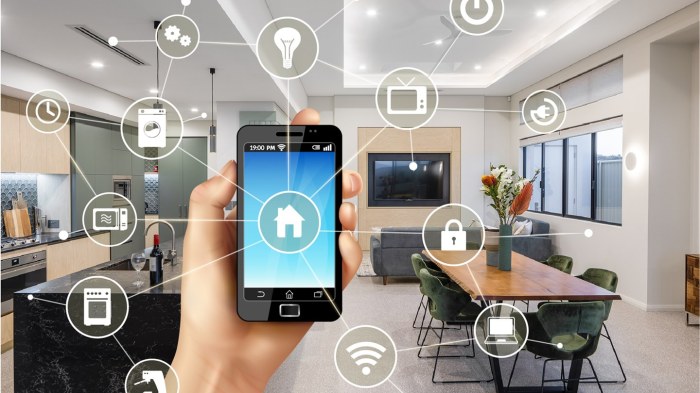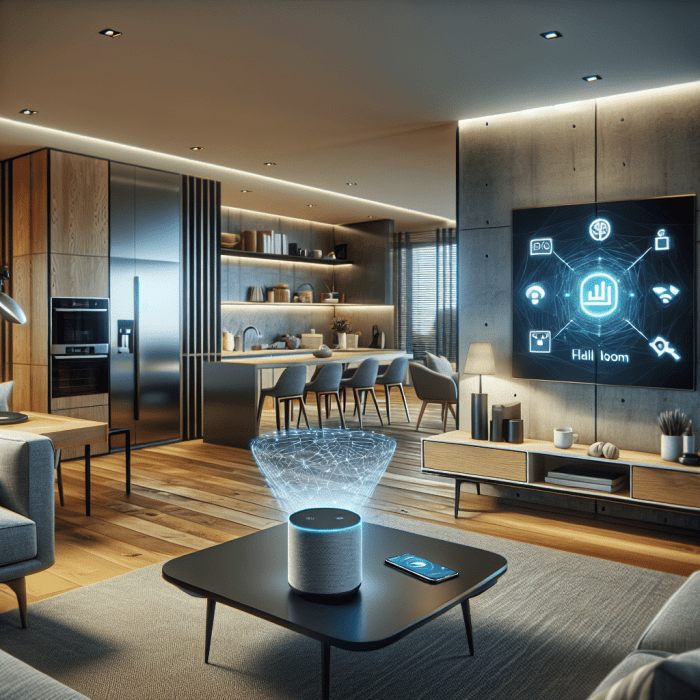Smart home technology integration takes center stage, beckoning readers into a world of seamless connectivity and convenience. Imagine a home where devices work harmoniously together, making your life easier and more efficient. This overview delves into the realm of smart home technology integration, exploring its benefits and potential challenges.
Overview of Smart Home Technology Integration

Smart home technology integration refers to the process of connecting and syncing various smart devices within a home to work together seamlessly. By integrating different smart devices, homeowners can create a more efficient, convenient, and secure living environment.Common examples of smart home devices that can be integrated include smart thermostats, smart lighting systems, smart security cameras, smart locks, smart speakers, and smart appliances.
These devices can communicate with each other through a central hub or a smart home automation system, allowing users to control and monitor them remotely through a smartphone or voice commands.
Benefits of Integrating Smart Devices
- Convenience: Integrating smart home devices allows for centralized control of various functions in the home, such as adjusting the temperature, turning on lights, or locking doors, making daily tasks more convenient.
- Energy Efficiency: Smart home technology integration can help optimize energy usage by automatically adjusting settings based on user habits and preferences, leading to potential cost savings on utility bills.
- Security: By integrating smart security devices like cameras, locks, and sensors, homeowners can enhance the security of their property and receive real-time alerts in case of any suspicious activity.
- Customization: With smart home integration, users can customize their home environment to suit their lifestyle, preferences, and routines, creating a more personalized and comfortable living space.
Challenges in Implementing Smart Home Technology Integration
Integrating smart home technology can bring numerous benefits, but homeowners may encounter challenges along the way. These challenges can range from compatibility issues between devices to connectivity problems that hinder the seamless operation of a smart home setup.
Compatibility Issues Between Different Smart Devices
When integrating smart devices from various brands, compatibility issues can arise due to differences in communication protocols or software requirements. For example, a smart thermostat from one brand may not be compatible with a smart hub from another brand, making it difficult for homeowners to control all their devices from a single interface.
- Ensure Compatibility: Before purchasing smart devices, homeowners should research compatibility requirements and choose devices that are designed to work together seamlessly.
- Use Universal Platforms: Opting for smart devices that are compatible with popular platforms like Apple HomeKit, Google Home, or Amazon Alexa can help minimize compatibility issues.
- Update Firmware: Regularly updating the firmware of smart devices can resolve compatibility issues by ensuring they are running the latest software versions.
Connectivity Problems in Smart Home Setups, Smart home technology integration
Connectivity problems, such as weak Wi-Fi signals or network interference, can disrupt the communication between smart devices and impact their performance. This can lead to devices going offline or experiencing delays in responding to commands, affecting the overall efficiency of a smart home system.
Enhance your insight with the methods and methods of Bohemian style home decor.
- Improve Wi-Fi Coverage: Extending Wi-Fi coverage with range extenders or mesh network systems can help eliminate dead zones and ensure stable connectivity throughout the home.
- Optimize Network Settings: Configuring network settings to prioritize smart home devices and reduce interference from other devices can enhance connectivity and improve performance.
- Professional Installation: Seeking help from professionals to install and set up smart home devices can ensure optimal connectivity and minimize the risk of connectivity problems in the future.
Security and Privacy Concerns with Smart Home Technology Integration
As smart home technology continues to advance, it is crucial to address security and privacy concerns to ensure the safety of personal data and prevent unauthorized access to smart devices.
Potential Risks of Connecting Multiple Devices to a Smart Home Network
- Increased Vulnerability: Connecting multiple devices to a smart home network can increase the vulnerability of the entire system, as each device becomes a potential entry point for cyber threats.
- Data Breaches: If a hacker gains access to one device on the network, they could potentially access sensitive personal information stored on other connected devices.
- Privacy Intrusion: Smart home devices are constantly collecting data about users’ habits and preferences, raising concerns about potential privacy breaches or unauthorized surveillance.
Tips for Safeguarding Personal Data and Preventing Unauthorized Access
- Secure Your Wi-Fi Network: Set up a strong and unique password for your Wi-Fi network to prevent unauthorized access to your smart home devices.
- Regularly Update Firmware: Keep all smart devices’ firmware up to date to patch any security vulnerabilities and protect against potential cyber attacks.
- Enable Two-Factor Authentication: Use two-factor authentication whenever possible to add an extra layer of security to your smart home system.
- Review Privacy Settings: Regularly review and adjust privacy settings on your smart devices to limit the amount of data collected and shared.
- Monitor Device Activity: Keep track of the activity logs of your smart devices to detect any suspicious behavior or unauthorized access.
Future Trends in Smart Home Technology Integration

The future of smart home technology integration is an exciting landscape that is constantly evolving with advancements in emerging technologies. From artificial intelligence to IoT and voice assistants, the way we interact with and control our homes is set to undergo significant changes.
Artificial Intelligence in Smart Home Automation
Artificial intelligence (AI) is playing a key role in enhancing smart home automation. AI-powered devices can learn user preferences and habits, allowing for more personalized and intuitive control of smart home systems. Through machine learning algorithms, AI can optimize energy usage, improve security features, and even anticipate the needs of users before they are expressed.
IoT Advancements in Smart Home Integration
The Internet of Things (IoT) is revolutionizing the way smart devices communicate and interact within a home environment. With IoT, various devices such as smart thermostats, lighting systems, and appliances can connect and communicate seamlessly, creating a more interconnected and automated living space. As IoT technology continues to evolve, we can expect to see even more devices becoming part of the smart home ecosystem.
Voice Assistants and Smart Home Control
Voice assistants like Amazon Alexa, Google Assistant, and Apple Siri have become integral parts of many smart homes, offering hands-free control and convenience. These voice-activated assistants enable users to control smart devices, play music, check the weather, and even order groceries with simple voice commands. As voice recognition technology improves and becomes more integrated with smart home systems, the possibilities for voice-controlled automation are endless.